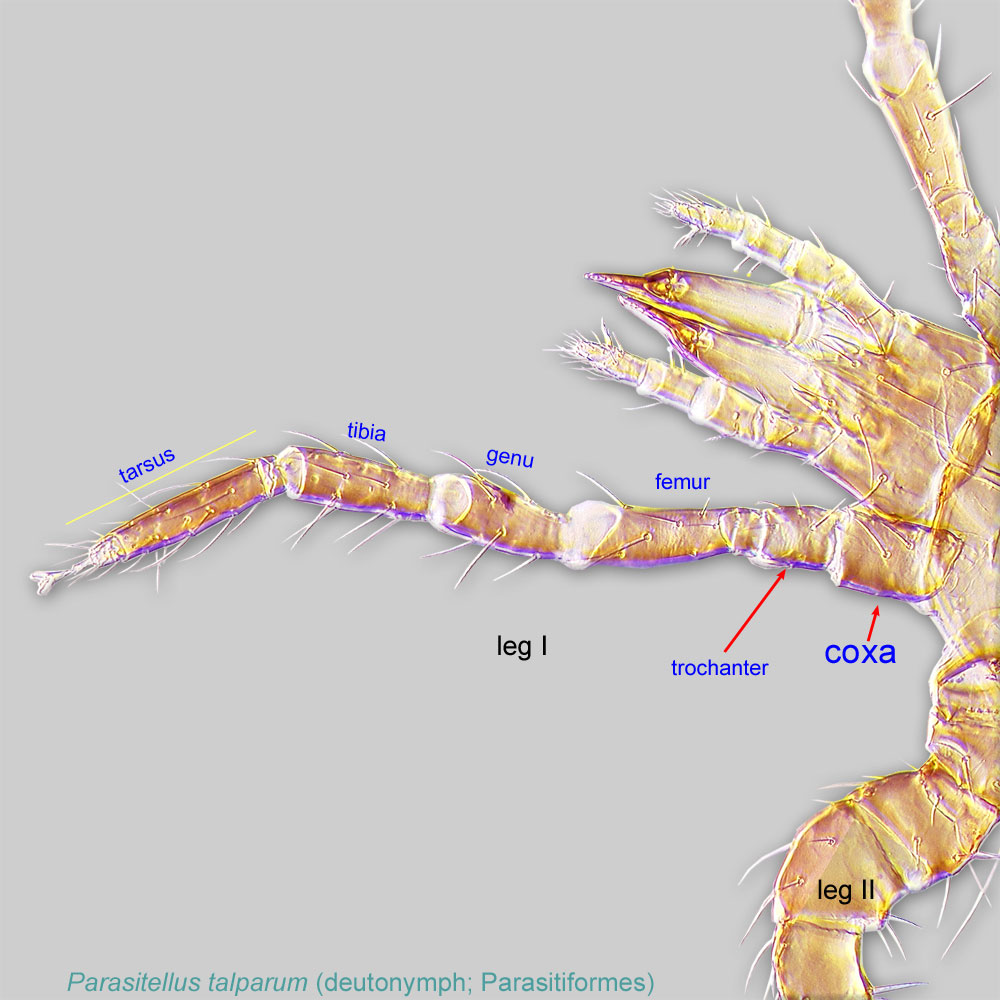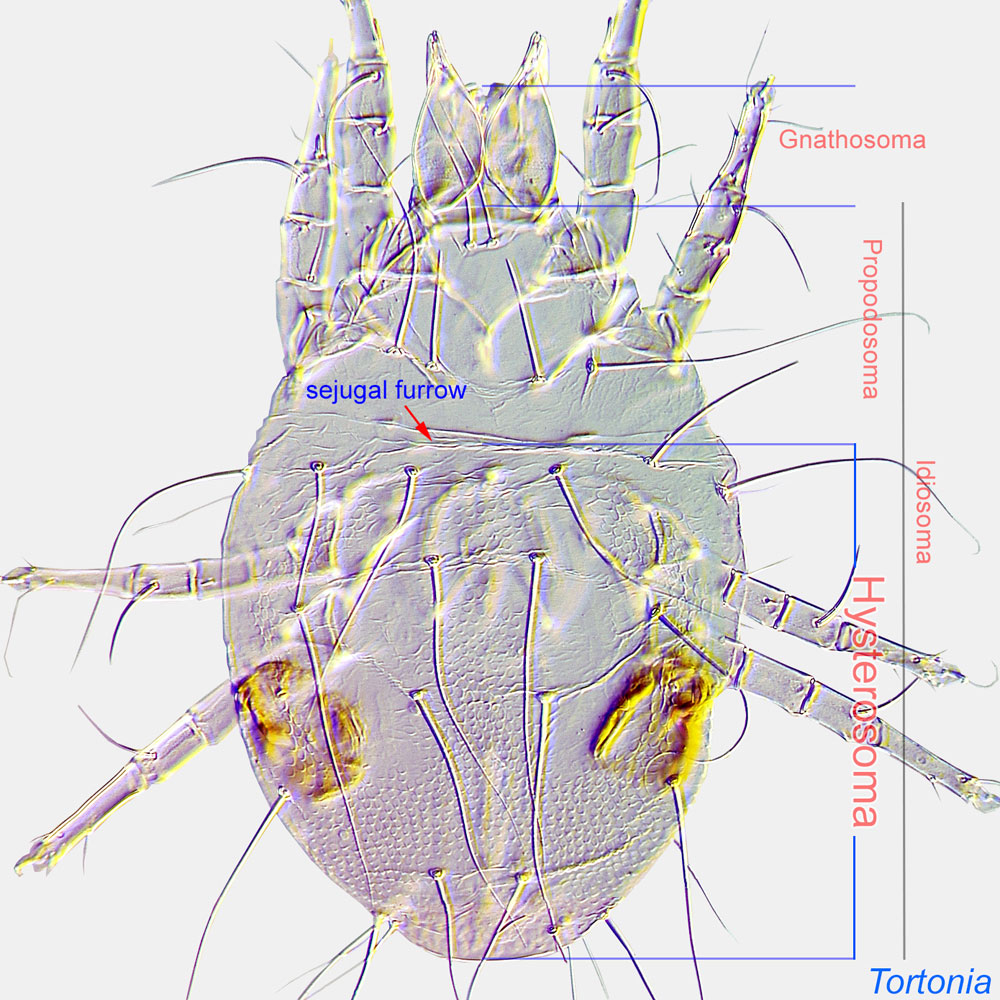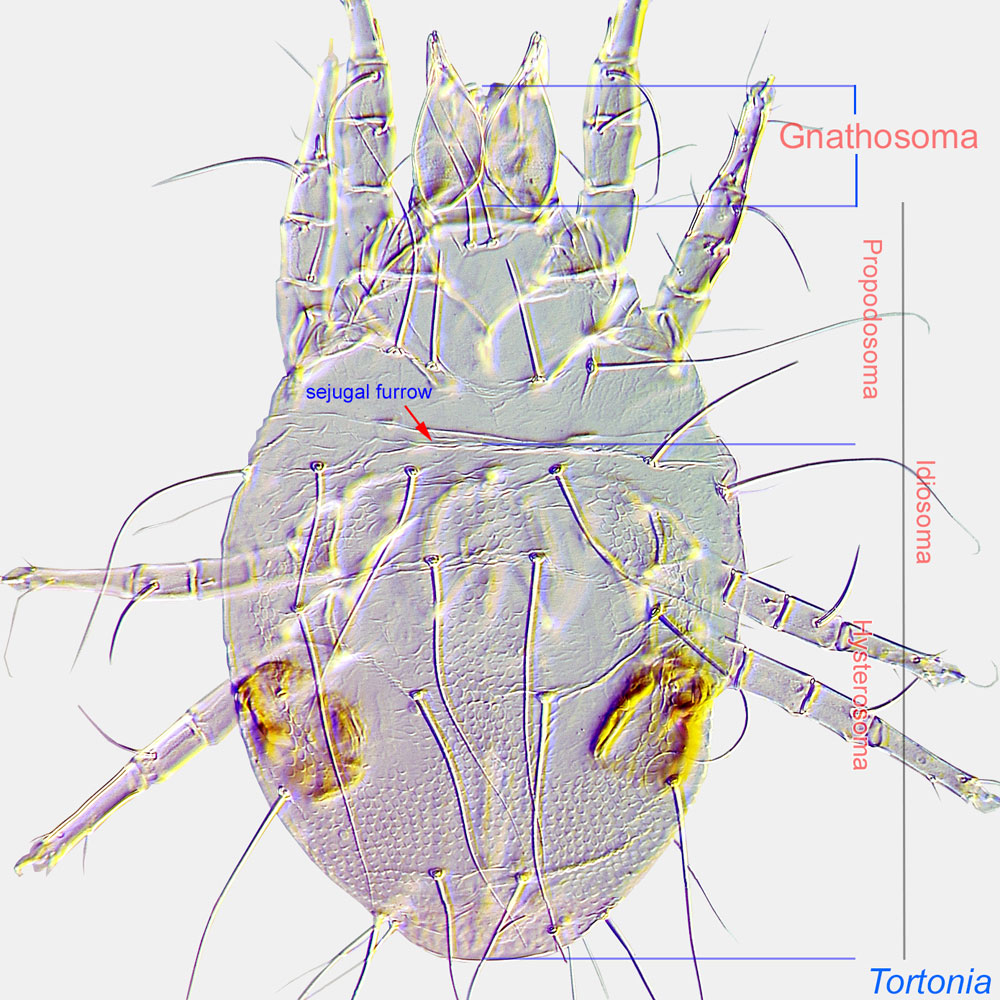internal parasite; feeds on hemolymph in tracheae and air sacs
Locustacarus Ewing, 1924
Superorder Acariformes » Order Trombidiformes » Suborder Prostigmata » Infraorder Eleutherengona » Hyporder Heterostigmata » Family Podapolipidae » Genus Locustacarus
Locustacarus trachealis Ewing, 1924
Bombacarus Stammer, 1951
tracheal mite
Larviform female: coxal setae II extending beyond posterior margin of coxaecoxa:
In Parasitiformes, most basal leg segment (or podomere) forming a joint with the body. Areas delimited by coxal apodemes are called coxal fields in Astigmata or coxisternal plates in Prostigmata.
 II (Fig. 2). CoxaeCoxa:
II (Fig. 2). CoxaeCoxa:
In Parasitiformes, most basal leg segment (or podomere) forming a joint with the body. Areas delimited by coxal apodemes are called coxal fields in Astigmata or coxisternal plates in Prostigmata.
 III with 1 pair of setae (Fig. 2).
III with 1 pair of setae (Fig. 2).
Larviform male: aedeagusaedeagus:
An external organ of a male arthropod that is specialized to deliver sperm during copulation.
arises on anterior hysterosomahysterosoma:
Division of body posterior to the sejugal furrow, bearing legs III and IV.
 and extends freely to gnathosomagnathosoma:
and extends freely to gnathosomagnathosoma:
Division of body anterior to the propodosoma bearing two pairs of appendages (palps and chelicerae).
 (Figs. 4, 6).
(Figs. 4, 6).
Adult female: Body sac-shaped. Only legs I present, legs II-IV absent (Fig. 3).
The family Podapolipidae is unique among other mites by having reproductive males and reproductive females at the larval stage. Hence larviform female (Figs. 1, 2) and larviform male (Figs. 4-7) have 3 pairs of legs. After insemination, larviform females molt to sac-like adult females with only 1 pair of legs (Fig. 3). Larviform males do not molt further. The number of legs can be different in other podapolipids.
Locustacarus buchneri and L. trachealis (associated only with Orthoptera) can be separated using a key from Husband and Sinha, 1970Husband and Sinha, 1970:
Husband, R. W. amp; R. N. Sinha. 1970. A revision of the genus Locustacarus with a key to genera of the family Podapolipidae (Acarina). Annals of the Entomological Society of America 63: 1152-1162.. Locustacarus masoni (from locusts) should be identified using the original description.
Holarctic region (Canada, USA, France, Germany, former Czechoslovakia, Denmark, Sweden, Poland, Russia, Armenia, and Japan); Oriental region (India); and Australian region (New Zealand)
Locustacarus buchneri occurs primarily in the respiratory system of bumble bees (Bombus), but occasionally has been found on the European honey bee (Apis mellifera).
permanentpermanent:
associated exclusively with bees or their close relative, wasps; cannot live without these hosts
Locustacarus buchneri only
Only one species, Locustacarus buchneri, is known from bumble bees. Locustacarus trachealis and Locustacarus masoni are respiratory parasitizers of Orthoptera.
Locustacarus buchneri is an internal parasite of bumble bees occurring in tracheae and air sacs. Husband and Sinha reconstructed its life cycle based on their observations in the USA (Husband and Sinha, 1970Husband and Sinha, 1970:
Husband, R. W. amp; R. N. Sinha. 1970. A revision of the genus Locustacarus with a key to genera of the family Podapolipidae (Acarina). Annals of the Entomological Society of America 63: 1152-1162.). In late April, Bombus bimaculatus queens emerge from overwintering sites in the soil. Within a few days, larviform female mites (Figs. 1-2) in the tracheae enlarge as they ingest hemolymph, and their ovaries begin to function. Nearly one week after emergence of a queen bee, mite eggs hatch. Males have poorly developed mouthparts (Figs. 4-7), are short lived, and do not leave the host bee. Larviform female mites migrate to the tracheae of worker bees, attach to the tracheal walls, molt, and begin to enlarge. Adult females (Fig. 3) have only two legs and a greatly distended body and cannot leave the host. In the first week in July, male bees and new queen bees emerge. Males of Bombus (Psithyrus) spp., B. vagans, and other B. bimaculatus occasionally enter the nest and may bring in or take out larviform female mites in their tracheae. By early August, new queen bees have mated, left the nest, and some may have entered diapause at sites several inches below the ground. After the new queen bees leave the nest, few new workers are produced and older workers accumulate more and more mites. The number of mites in worker and male bees in August is sufficient to severely injure the bees. Diarrhea has been observed, and some bees are lethargic and no longer forage. Because worker bees, male bees, and the old queen bee die during fall, the only mites that survive to the following April are in the tracheae of young queens in diapause.
Bumble bees with Locustacarus buchneri had significantly reduced lifespans in the laboratory (Otterstatter and Whidden 2004Otterstatter and Whidden 2004:
Otterstatter, M. C. amp; T. L. Whidden. 2004. Patterns of parasitism by tracheal mites ( Locustacarus buchneri ) in natural bumble bee populations. Apidologie 35: 351-357.).
This species was introduced to Japan with commercially bred Bombus terrestris from Belgium and Netherlands (Goka et al., 2001Goka et al., 2001:
Goka, K., K. Okabe, M. Yoneda amp; S. Niwa. 2001. Bumblebee commercialization will cause worldwide migration of parasitic mites. Molecular Ecology 10: 2095-2099.).
A single work reports this mite from the honey bee, Apis mellifera, in Poland (Tomaszewska, 1988Tomaszewska, 1988:
Tomaszewska, B. 1988. [Mites as parasites of honey bee ( Apis mellifera L.) and as beehive co-inhabitants]. Wiadomosci Parazytologiczne 34: 177-84.).